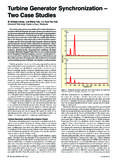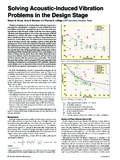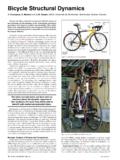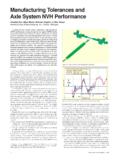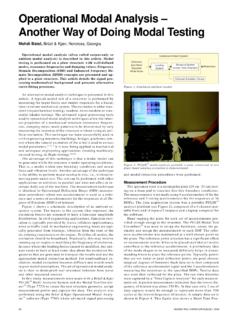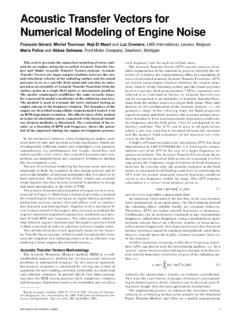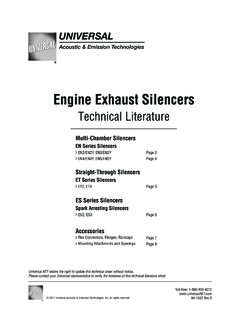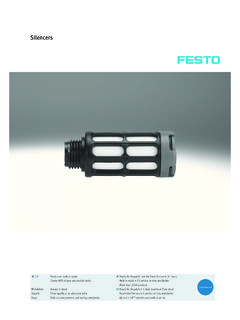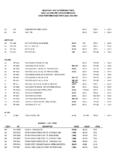Transcription of A Guide for Specifying and Selecting Vent and Blowdown ...
1 SOUND & VIBRATION/JULY 2016A Guide for Specifying and Selecting Vent and Blowdown SilencersIf you are tasked as an engineer to develop a specification for the purchase of a vent or Blowdown silencer, it can appear somewhat overwhelming due to the high mass flows, pressures and temperatures involved. It doesn t have to be. This article will define a vent silencer specification data sheet and discuss each of the important fields that must be completed on the form, including background considerations. The information imparted encompasses the applied knowledge of acoustical theoreticians and vent silencer industry practitioners from over the last 50 years.
2 The outcome should be a better understanding of the fac-tors involved and information needed to specify and select the appropriate vent silencer for a given application, without over- or under-designing it. This article defines a vent silencer specification data sheet and covers each of the important fields that must be completed on the form. These fields include those that must be identified by the purchaser and those that must be supplied by the silencer vendor. Understanding all of the factors involved will make to easier for you to select the right vent silencer for the application at first, we will introduce vent and Blowdown silencers and review the basic factors involved in predicting the noise generated by high-pressure vents .
3 Listed here are the vent and Blowdown applications that require silencers : Steam venting in power generation applications Natural gas compressor station and pipeline blowdowns Process control and relief valves in industrial applications Blowdown tanks and autoclaves Bypass valves on blowers and compressors Steam ejectors and hogging vents Discharge of high-pressure gas to substantially lower pressure environment (atmosphere). The high-pressure gas can be steam or natural gas, which ac-counts for more than 90% of the applications, as well as air, ni-trogen, oxygen, hydrogen, carbon dioxide, combinations thereof, and other that the terms vent silencer and Blowdown silencer refer to the application for which each is used.
4 They are equivalent silencer designs and are referred to as vent silencers when being used to vent at a constant flow rate for a period of time. They are referred to as Blowdown silencers when they are blowing down a finite volume of gas starting at a high pressure and ending at a low pressure over a given time. Vent silencers are sized for constant flow and Blowdown silencers are sized for maximum Generated by High-Pressure VentsOver the years, there has been a good deal of work done in the field of predicting the noise generated by the high-pressure venting of gases.
5 This has resulted in the development of several empiri-cal models supported by field evidence and tabular data on the subject. There are a number of open sources in the public domain providing access to these models and will not review these models but will touch on the key factors involved in predicting the noise generated by high pressure Influencing Noise Generated by High-Pressure vents . Mass flow the higher the mass flow, the noisier it becomes. The type of gas and its molecular weight/specific gravity lighter gases are noisier.
6 Temperature higher temperatures result in lighter gas flows, and therefore, higher noise levels. Upstream versus downstream pressure the higher the upstream pressure is relative to downstream pressure, the louder it will be. Choke flow (critical flow or sonic flow) occurs when upstream pressure is roughly two times or greater than downstream pres-sure, making things much noisier. Orifice/opening size of valves, vents , orifice plates, diffusers, etc. larger diameters result in low frequency noise, while smaller diameters produce higher frequency noise.
7 For instance, diffus-ers create a shift in the noise spectrum from low frequency (one large vent opening) to high frequency (many smaller openings), which is much easier to Creating Noise in High-Pressure Venting Systems. The noise at the end of a high-pressure vent pipe is a combination of the noise generated by the high-pressure-drop elements in the system. Essentially, any element that has a high-pressure drop across it or large change in area will create noise and should be included in the noise model to accurately predict overall noise level.
8 The major elements that create noise in high-pressure venting systems are: Pressure relief and control values present in virtually all venting systems. Vent pipes/nozzles last element in venting systems, except for those using high-pressure silencer diffusers. High-pressure silencer diffusers when included, usually designed to provide a specific backpressure at the rated flow (sometimes used as fail-safe device). Orifice plates included in many systems as a flow regulator or fail-safe device. Enlargers (reducers), headers and abrupt transitions included in pipe systems for various Noise Versus Turbulent Mixing.
9 There are two phenomena that produce noise in a high-pressure venting system: Shock noise occurs when a choked flow condition exists Turbulent mixing caused by the ripping of the air as the vent gas decelerates to lower velocity, such as the noise is the louder of the two. By adjusting the elements in a piping system it is possible to reduce the shock noise by reducing the magnitude or quantity of choked flow conditions present. Turbulent mixing, on the other hand, is always present, though less of an Silencer Data SheetMany engineering concerns, consultants, manufacturers and end-user companies have developed forms for the specification and evaluation of vent silencers over the years.
10 The vent silencer data sheet shown in Figure 1 is a compilation of those data sheet is color coded to identify purchaser-supplied in-formation (general, important and necessary) and vendor-supplied information (important and necessary). Following the specification and evaluation process presented in the data sheet will provide a silencer selection that best meets the needs of the that we not address the general purchaser information noted on the data sheet. It goes without saying that the purchaser should provide these data for record keeping and document-control DescriptionHere the vent silencer operating conditions are identified along with details regarding the vendor and the equipment that they are proposing.

